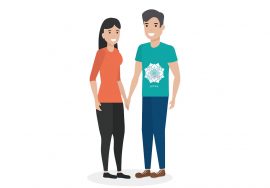
CLEANSING AND STRENGTHENING THE SVAADISHTHAN (SACRAL) CHAKRA
According to the Yogic philosophy there are seven main chakras (energy centres) in our body, namely, Mooladhar (root) chakra, Svaadishthan (sacral) chakra, Manipur chakra (solar plexus), Anhata (heart) chakra, Vishudha (throat) chakra, Agya/Ajna (third eye) chakra and Sahasrar (crown) chakra.
Of these seven chakras, from the health perspective, third (Manipur) chakra is the most important one and Svaadishthna (Sacral/second) chakra is the second important chakra in our body.
This chakra is situated just about four fingers below the third/Manipur chakra. This chakra controls and influences the water element in our body. The water element is represented by all kinds of fluid/liquid in our body, e.g. plasma, blood, vital fluid (semen in men and cervical/menstrual fluid in women), urine, sweat, tears, etc. and at the subtle level, our emotions are influenced by the water element.
The word Svaadishthan is a combination of two Sanskrit words, i.e. “Svaad”, which means taste, and “Sthan”, which means place. Hence the meaning of Svaadishthan is – it is the place from where the taste, or the ability to experience and relish the taste, sprouts or originates. The ability to relish is not restricted to only the physical level in the form of relishing good food, but is also at the emotional level in the form of enjoying soothing music, having meaningful discussions that uplift us at emotionally and mentally, etc. In other words, when this chakra is strong and healthy, it promotes positive feelings like being satisfied, happy, content, complete, equipoised, etc.
When this chakra is healthy and functioning well, the required quantity of saliva is produced in the mouth when we eat (or even when we think of having some tasty food), sufficient quantum of digestive juices are produced in the digestive system, which helps to digest the food properly and transform it into the seven healthy tissues, i.e. plasma, blood, muscles, etc., resulting in the production of pure wholesome vital fluid (semen in men and cervical & menstrual fluid in women).
This chakra is also responsible for maintaining the health of the vital glands/organs which produce sex hormones, i.e. testicles in men and ovaries in women. When this chakra is healthy, men can have substantial quantity of semen, good quality sperms with sufficient life span and normal motility; while women can have healthy uterus and ovaries, helping them to have regular/normal menstruation without PMS, regular ovulation with eggs maturing at the normal time, easy conception, normal and healthy pregnancy, natural delivery of a healthy baby without any need for C-section, fast recovery after delivery with proper lactation and good quality breast milk.
When this chakra becomes weak and the energy flow towards and around this chakra is disturbed/blocked, then one may experience several adverse effects which generally cannot be completely rectified by taking medicines. Some of these adverse effects are: anaemia, acidity, scanty urine, migraine, dizziness, vertigo etc. In women, it can manifest as excessively heavy or too light menstrual flow with lots of PMS related problems, low libido, difficulty in conceiving, miscarriage, lactation problem, etc., while in men, it can manifest as low sperm count, premature ejaculation, emission without ejaculation, frequent wet dreams, erectile dysfunction, etc.
FORTUNATELY, there is a very simple solution given in Yoga which can help to maintain the health of the sacral chakra and thereby rectify and prevent the above mentioned adverse effects of the weak second chakra. The technique is as follows:
Technique:
- Sit on a jute or cotton rug or on a Yoga mat, stretching your legs straight in front.
- Bend both your knees and bring the soles of the feet close to each other facing inward.
- Hold the toes in between your interlocked fingers and pull the feet inward so that the heels are touching the perineum region (between the genitals/vagina and anus).
- Push the knees down towards the floor as far as possible till the thighs and calves touch the floor (rug/yoga mat).
- Straighten your back and maintain this position breathing normally for a few moments. This is called “Badhakonasana” (cobbler’s pose/butterfly pose).
- Breathe in deeply and at the same pull the nerves and muscles in the perineum area upwards towards the navel.
- Hold the breath and keep the nerves and muscles contracted as long as possible.
- Breathe out and relax the nerves and muscles.
- Repeat steps 6 – 8 for 5 times to begin with. And with regular practice, when you gain good control over the nerves and muscles, you can do it even up to 100 times.
- Raise your knees upwards till they come close to each other.
- Stay in this position for at least 10 seconds.
- Straighten your legs and shake them gently to normalise blood circulation in the legs.
Precautions:
- Do not do steps 6 – 8 above for at least 3.5 hours after eating and for 2 hours after drinking water. But “Badhakonasana” (steps 1 – 5 above) can & should be done right after eating.
- Make sure your bowels and bladder are clean/empty. Otherwise, this exercise can have harmful effects on the bladder, urethra, kidneys and colon.
- Do not jerk while bending and straightening the knees.
- The back should be kept completely straight.
- Proper attention will be required to keep the knees down especially while breathing in and pulling the nerves & muscles in the perineum region upwards, as this will draw extra energy, at least initially, and may cause some trembling effect on the legs, particularly on the inner thighs, and therefore can cause unintentional raising of the knees upwards.
- Do not straighten the legs immediately after finishing the technique.
- Always raise the knees upwards first, stay in that position for a few seconds and then straighten the legs.
- This is necessary to relax the muscles and nerves in the inner thighs, which are stretched while maintaining this pose. If this is not done, then it can have damaging effect on them and in the long run this simple negligence can cause hernia problem.
Benefits:
- Sitting in Badhakonasana on an empty stomach can facilitate unification of Prana Vayu and Apana Vayu. And if this posture is maintained for a considerable period of time, (for 3 hours and 48 minutes, equivalent to 9.5 “ghadis”, to be more precise), the Prana can start flowing through the “Sushumna Naadi, which is the most significant naadi out of 7, 272, 210 naadis.
- The contraction and relaxation of the nerves and muscles in the perineum region helps to speed up the energy flow in, around and towards the second chakra by removing the blockages within the energy channels in that region.
- This in turn rectifies almost all the problems relating to anus, rectum, colon, reproductive organs, etc.
- Therefore, several problems like piles, haemorrhoids, polyps in the anus (fistula) & colon, cysts in the ovaries, fibroids in and outside the uterus, twisted fallopian tubes, irregular ovulation and menstruation, cysts/lumps in the breast, PMS related problems, leucorrhoea, candida, low sperm count, premature ejaculation, emission without ejaculation or ejaculation without emission, erectile dysfunction, low libido (in men & women) etc. can be resolved in a very short period of time and the benefits derived by doing this technique regularly even for a week can be of very long lasting nature.
- This technique is equally beneficial for men, women, young, old, married, single, a householder and a celibate/monk.
- This simple technique not only has a cleansing effect on the second chakra but it also tones up the whole reproductive system.
- According to Ayurveda, when the quantity and quality of the water element in the form of different fluids, e.g. plasma, blood, etc., particularly the vital fluid (semen in men and cervical/menstrual fluid in women), is more balanced, then it ensures good emotional and mental health for the individual.
- This helps one to feel more confident, optimistic, creative, compassionate, humble, flexible at the physical level and adaptable at the subtle level (without compromising with one’s basic ethics/principles).
- In Ayurveda and Yoga, it is also mentioned that the benefits derived by doing this simple technique can be of long lasting nature compared to those derived by taking any strong medicines.
To book an online appointment at Ayuryoga, with our Ayurveda/Yoga Expert Mr. Vinod Sharma Hong Kong please click here.












